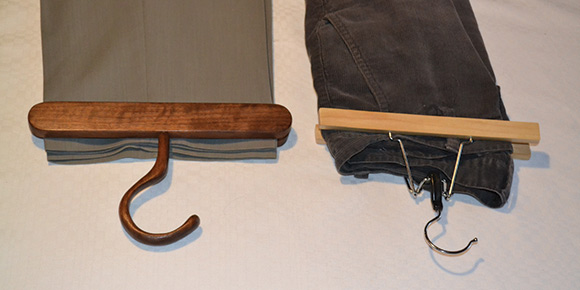According to the best dressed men, pants should be hung by the cuffs — not the waistbands — to maintain a crisp crease and to prevent wrinkling when stored in a cupboard. One of the banes of my life are cheap wire and wood hangers manufactured to such imprecise specifications they are incapable of supporting a few sheets of paper, let alone a pair of pants.
As I am a sucker for a deal, I own several of these hangers which only work if I fold my pants at the waistbands and then place them between the flimsy wood jaws. Aside from crumpling the belt hoops and creating a messy fold, this technique does not guarantee the pants will remain airborne. Often, when I reach into my closet to release a pair of trousers from a hanger, an entire row of similarly hung pants will drop to the floor in unison; apparently, to observe is to disturb in the strange worlds of particle physics and mass-produced hangers.
If you own these gadgets, you are aware of how vexing this dilemma can be. What’s the solution?
My answer was to design and build a hanger of scrap hardwood and rare earth magnets capable of supporting a pair of pants by the cuffs, without the pants serendipitously falling to the ground. Here’s how to do it:
Start by tracing the shape of a 1/8-inch wire hook onto a piece of scrap softwood and then expand the width with French curves to about 3/8-inch around the circumference and stem. Cut out the hook with a jig or band saw to create a template.
Laminate together two pieces of hardwood 4-inches by 6-inches by 3/16-inches thick, with the grain running at right angles; a non-laminated board will break at the long or short grain, depending on which direction you orient the hook.
Place the hook template on top of the laminated board and trace its outline with a dark marker onto the hardwood. Use a jig or band saw to cut out the shape.
To create a rounded hook, start the shaping process with a rasp, graduating to a file and finally #80 and #120 sandpaper. Dremel bits or power sanding discs and cylinders will speed up this process.
When the hook is completed to your satisfaction, cut out two hardwood jaws 1/2-inch thick by 1-1/2-inch wide and of sufficient length to ensure your pant cuffs will not overlap the magnets, which will be installed at either end of the jaws. (My suit pants have a 9-inch wide cuff, so I cut my jaws 12-inches long to allow room for the 7/8-inch round magnets.)
Drill a 3/8-inch hole into the top of the jaw to receive the hook’s base. (I had to whittle the base of my hook so it could be fitted and glued like a dowel into the hole.)
On the opposite jaw, remove about a 1/4-inch by 9-inch (or width of your cuff) length of wood to create a slot to accommodate the thickness of your pants.
If you like, round the ends of the jaws for a more aesthetically pleasing design.
Install the rare earth magnets, cups and washers on the inside flat edges at the ends of both jaws by drilling a 7/8-inch hole with a Forstner bit. The holes in the jaw with the hook attached should be 3/4-inches OC from edge to edge and about 5/8-inches OC from the rounded ends of the jaw. (The magnets and cups I purchased require a
1/4-inch deep hole to allow them to sit level with the wood’s surface.)
Install the washers on the opposite jaw in the same manner. For optimum holding power, you are better off to mount the washers so they are slightly above the surface of the wood. (Instead of screwing the magnets, cups and washers into the holes, I epoxied them into place because the jaws were not thick enough to accommodate even very short screws without the ends piercing the outside faces of the wood.)
Use #120-paper to final sand the hanger, followed by three coats of water-based urethane, rubbed out between coats with #400 wet/dry sandpaper to ensure a silky, rich and resilient finish.
davidsquare81@yahoo.com



